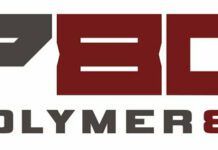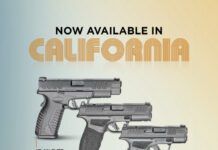Big guns may be the stuff of movie legends but in the world of the CHL (concealed handgun license), smaller pistols are more likely the stars. We recently tested five smallish guns that shoot big bullets: They were the $566 .40 S&W Springfield XD40 SC HC, Glocks $614 .45 GAP Model 39, and three others chambered for .45 ACP. They were the $830 Smith & Wesson CS45 Chiefs Special, the $421 Taurus PT145 Pro SS, and the $637 Glock 30.
How We Tested
For each caliber we chose two hollowpoint defense rounds and one full-metal-jacket target round. The .40 S&W rounds consisted of Winchester USA 165-grain FMJs and jacketed hollowpoints from Black Hills Ammunition, topped with 165-grain and 180-grain slugs respectively.
The self-defense .45 GAP rounds were 185-grain Hydra-Shok loads from Federal and 200-grain Gold Dot hollow points from Speer. Speers 185-grain Lawman full-metal-jacket ammunition rounded out the GAP selections.
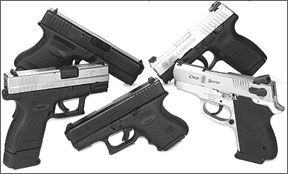
For the .45 ACPs, we chose 230-grain and 185-grain JHP rounds from Black Hills Ammunition as well as the Winchester USA 185-grain FMJ load.
We began by establishing benchrest accuracy from a distance of 15 yards. Since the size of each gun offered little area for support, we adapted an outstretched shooting style with the tester sprawled across a long bench in a manner similar to the prone position. The gun was supported by a small sandbag beneath the dust cover.
To answer questions related to how the guns might be used in the field, we devised a course of fire presenting several practical problems. We placed three cardboard targets 5 yards downrange spaced 5 feet apart edge to edge, with the center of each target covered by a white piece of paper measuring 8.5 inches by 11 inches. Target height was 48 inches at the uppermost edge.
We placed a 30-inch-tall barrel in front of the center target to be used as a flat surface. We began each string of fire with the test gun resting left side down atop the barrel with the muzzle downrange, magazine out and the slide locked back. Two magazines loaded with FMJ ammunition were placed next to the gun. Hands were placed grasping their respective edges of the barrel at 4 oclock and 8 oclock.
Upon start signal, we picked up the gun with one hand, grabbed the magazine with the other and loaded the gun. We released the slide and engaged each target with two rounds apiece holding the gun in both hands. After the sixth shot we dropped the magazine and reloaded by picking up the spare magazine from the barrel top.
The three targets were re-engaged with two shots each with the gun held in the strong hand only (i.e., right hand for right handed shooters). This exercise was repeated with the shooter firing the final six rounds with the weak hand only. Elapsed time was recorded by a shot-sensing timer and the targets were scored for hits on the white paper only.
By forcing the shooter to manipulate the gun through multiple challenges in rapid succession, we felt we could learn more about each gun than by merely shooting supported or plinking offhand. Here is what we learned.
Glock Model 30 .45 ACP, $637
Our G30 offered Glocks basic package of a white outline rear sight, and white-dot front sight. There was room for one small light to be mounted beneath the dustcover by way of a single crosscut in the accessory rail. The only upgrade we found was what appeared to be an extended magazine release.
Compared to the Glock 23 (see page four of the December 2006 “Guns of the Year” article), the magazine release jutted out smartly on the left side. But hand position on the smaller frame prevented any accidental contact. The front strap offered two finger grooves, and the rear of the grip formed a small palm swell with a small overlap at the magazine well.
The magazine held 10 rounds, and the beefy basepad added to the shooters grip. With the magazine in place, the G30 not only looked larger than it actually was, but afforded a full grip to most shooters.
When it comes to small semi-automatics, one theory has been that lighter, faster bullets would run the guns more reliably. The reasoning behind this was that guns with shorter slides and less slide mass must be cycled with enough force to move the slide fully to the rear to give the gun time to eject spent shells and pick up a loaded round from the magazine. We soon found that current technology seems to have conquered this problem, because all five of our test guns ran without failure.
Nevertheless, our G30 was more accurate from the bench with each of our 185-grain rounds than the 230-grain hollowpoints. Accuracy with both the Winchester USA FMJ rounds and the Black Hills JHP ammunition produced an average five-shot group measuring 1.7 inches across. The 185-grain Black Hills JHP remanufactured ammunition (loaded into unmatched cartridge cases and sold in blue 50-round boxes) offered the most power (about 340 ft.-lbs. of muzzle energy).
Immediately after completion of our benchrest session, we began our “practical” test. Our first run was completed in 13.71 seconds, with one miss on the right side target. The first shot was fired at 2.78 seconds. Our second run that transitioned to the weak hand took 16.29 seconds to complete and we found two shots off target to the right. The first shot was fired at 2.99 seconds from the audible start signal.
Here is what we learned in this crucible of time and operational stress: The slide release on the G30 was too small. Grasping the rear of the slide and pulling it back as the receiver was pushed forward was much more efficient.
With two hands the G30 felt consistent from shot to shot and steered quickly from target to target. In this process we led with our eyes and pushed the gun to the next target on the right. The G30 was easy to stop on target and we didnt feel that the gun was changing in terms of control as the weight added by the rounds in the magazine was reduced.
In our first set of runs we loaded enough rounds so that the gun would not run dry and lock the slide back after the sixth shot. We decided it would be prudent to test again with the gun running to slide lock before the reload. This string of fire produced identical accuracy but was about one second faster.
Why was it faster to reload from slide lock than to a gun with the slide already forward? Because with the magazine empty and the slide locked back, the magazine dropped freely. With the slide forward we had trouble releasing the magazine and were forced to strip it manually from the receiver. But this was our own fault.
We also learned that dropping the magazine required us to turn the gun so that the palm of the hand does not block the falling magazine. We found that even brief contact with the edge of the basepad could result in the magazine being unlocked, but sitting ajar, stuck inside the magazine well. The key to a clean release was to pinch the gun between the thumb, placed directly on the release, and the middle finger. The remaining fingers needed to be held away from the grip.
Nevertheless, we found this technique easier to apply when the slide was locked. This is because with the slide fully to the rear the balance of the gun made it easier to reach the release button and let the magazine fall clear of our hands.
We also learned several other techniques from shooting the G30. Using only one hand, we learned that it was safer and faster to reach for the gun by moving the strong hand inward from the bottom of the grip. Quickly dropping the hand straight down on the grip sometimes resulted in a finger entering the trigger guard.
For two-handed acquisition, we like to scoop underneath the rear of the slide with the weak hand middle finger and flip it into the strong hand. In our experience this assures the best shooting grip. But this proved to be problematic because the side of the Glock pistol was too flat, leaving little or no room for the finger to get underneath.
Once in hand, finding the magazine well was easy and loading went quickly. We found that firing the G30 strong hand only was not difficult, but one-handed shooting with the weak hand demanded much more practice.
Taurus Millennium
PT145 Pro SS No. 145SSP
.45 ACP, $421
The PT145 Pro SS offered a lot of features in a small package. It had an accessory rail underneath the dustcover, a key-operated lock that seized both the slide and the trigger, a thumb-operated safety, and Richard Heinies Straight Eight sights.
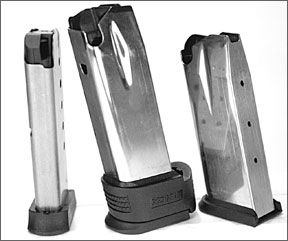
The sights get their name from the intended sight picture created by placing the dot found on the front sight directly above the single dot found in the center of the rear sight. This forms the numeral eight. The dots were not self illuminating, but both the front and rear units were dovetailed into place and lined to reduce glare. The rear unit was windage adjustable by drift only.
The PT145 pistols differ from the Taurus 24/7 series primarily in the manner in which the frame meets the slide. The polymer receiver of the 24/7 design is attached to a sub frame that includes the rails on which the slide will connect. This creates maximum metal-to-metal contact.
The PT145 places most of its stress on a steel locking block found just below the barrel chamber. The rails to the rear were polymer and molded as one piece with the frame. These rails play more of a guiding rather than weight-bearing role.
Shooting from the bench, we learned that the trigger had a great deal of take-up. We measured the actual distance to be about 0.5 inch, which seemed like forever compared to our other pistols.
But the Taurus did feature “double-strike” capability. The striker will deliver a blow every time you pull the trigger regardless of
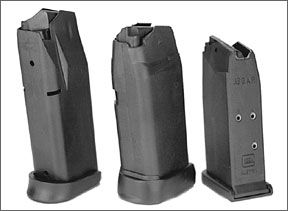
whether the slide has moved. This should come in handy if for any reason a round does not go off the first time. But we suffered no such problem.
There was, however, a marked difference in this guns preference for ammunition. Our best results came with the rounds that recoil the most. It seemed like the gun locked up better when cycled with authority, as we managed a best single group of 1.2 inches firing the Black Hills 230-grain JHP ammunition.
But power was not up to the level produced by the Glock 30 or the Smith & Wesson CS45 pistols. Average muzzle energy was about 261 ft.-lbs. for all three choices of test ammunition.
A quick look at the bench session would rate the Taurus PT145 Pro SS pistol last in accuracy and power. But in our close-quarters practical test, the results were turned upside down. Acquisition, loading, and firing the first shot from the Taurus took 2.68 seconds on the first run and 2.98 seconds on the second run. Total elapsed times were 13.26 seconds and 14.89 seconds respectively. Both runs produced twelve of twelve required hits on string one, (transition to strong hand only), and eleven hits on string two (transition to weak hand only).
What made this time remarkable was that we had to strip the magazine manually from the receiver to complete the reload. The problem was that one magazine would drop free and the other would not. Even with the slide locked back, the offending magazine would not drop free. This was not purposely designed but rather caused by a magazine that was out of spec. Firing the first six rounds from the drop-free magazine would have put the Taurus way out in front in terms of elapsed time. We made a note to carry the magazine that was a little too fat on our belt rather than loaded in the gun.
We found in our slide-lock trials that the release was readily available and worked without fail. This gave us the option to pull back the slide or press the release to charge the pistol.
Our staff agreed that the Taurus PT145 Pro SS had a big gun feel to it. The grip was full size, and we soon got over the distraction of the long take-up in the trigger. During one-handed fire, it felt about the same whether we were shooting with the left or right hand.
The sights were easily visible, and the gun didnt overreact during recoil.
We found the left-side thumb safety difficult to apply, but much easier to push downward, making the gun ready to fire. The safety lever itself was not very wide and didnt get in the way or snag on clothing. It did, however, prop the gun up just enough to make our two handed drill of scooping the pistol into the right hand off of the barrel top a simple chore.
Smith & Wesson CS45
Chiefs Special No. 103014
.45 ACP, $830
The CS45 Chiefs Special differed from our other test pistols in a number of ways.
First, the CS45 is built utilizing alloy rather than synthetic frame material. Also, the gun can be fired by either a single- or double-action trigger. With the hammer lowered safely over a chambered round (decocked), the first shot will require a longer pull that both raises the hammer and releases it. Should the gun not fire, the trigger can be pulled again for a second or third hammer strike.
After ignition subsequent shots will be fired single action only as the movement of the slide will cock the hammer after each shot (traditional double action or, TDA). The Smith & Wesson TDA system adds a safety wherein the decocker lever can be left in the downward position to disconnect the trigger. In addition, releasing the magazine will also render the gun safe.
The magazine disconnect will disable the trigger even when the magazine has been left ajar or not completely removed. These safety systems can prevent disaster during a gun grab by setting the decocker lever on safe or by releasing the magazine during a struggle. It could also prevent disaster should a less knowledgeable person remove the magazine and press the trigger without clearing the chamber.
From the bench our Chiefs Special produced an average size group measuring less than 2 inches across with each of our three test ammunition. The CS45 delivered a 0.8-inch five-shot group firing the Winchester USA 185-grain FMJ rounds and was our most accurate .45 ACP pistol. Overall, power was less when compared with the longer barreled Glock G30.
Our next question was how the TDA trigger would affect accuracy under pressure. The first shot double action required 14 pounds of pressure. The second shot not only moved the position of the trigger to the rear approximately 0.3 inch, but presented about half as much resistance. The first time we tried two consecutive shots transitioning from double to single action we landed our first shot low. Then we changed to a higher, more balanced grip and set our minds to ignore any anticipation of breaking the shot.
From this point on we squeezed the trigger and let it reset moving our trigger finger in an even stroke ignoring any change in resistance or length of travel. The Chiefs Special responded with outstanding accuracy.
Firing our practical test beginning with the hammer back and all shots single action, we dropped one hit during the weak-hand-only string. Beginning with the gun firing double action for the first shot, our practical test was free of any missed targets.
We felt the reason for our success was the ergonomics of the pistol. Despite its short frame with the magazine basepad barely adding room for the pinky, the CS45 is a narrow single stack pistol that points naturally. The Hogue rubber grip that envelops the back strap plants the gun in the hand. If anything the gun was too stable, the tacky rubber grip sometimes making it difficult to shift the gun in our hands.
But there was more to learn about fast handling the Smith & Wesson CS45 Chiefs Special.
When loading or reloading the pistol, technique was key. The six-round magazines veritably shot out of the receiver so no rip-and-strip drills were required. But inserting the single-column magazines left less room for error than the other guns fed with tapered magazines into widebody frames.
Keeping the gun high and tilting the gun enough to see the inner edge of the magazine well was key to a quick reload. Our first run that began with loading, releasing the slide and firing took 3.15 seconds from start signal to first shot fired single action. To charge the gun we found that pulling on the back of the slide would not work. But hitting the slide release proved to be 100-percent reliable. We would prefer having the option to use both methods.
In a comparison of speed to firing from first shot single action against first shot double action, we found little or no difference in elapsed time. The single-action trigger was more precise, but breaking a double action shot required only a balanced grip as we mashed the trigger.
The Smith & Wesson was a little heavier with the least felt recoil, in our view. But we thought each of our .45s proved to be surprisingly soft shooters. The CS45 had a narrow frame, but the grip was wide front to back. The top end was about as wide as the Glock pistols, but overall this gun carried with the least imprint on clothing.
Glock 39 .45 GAP, $614
Primarily, .45 GAP ammunition differs from .45 ACP in terms of size. The GAP cases are shorter, and the primer pocket is smaller. At first look, the small pistol primer can look a bit lost in the center of the headstamp.
With this in mind perhaps it was only fitting that the Glock 39 was the smallest pistol in this test. Despite the barrel measuring just a hair longer than 3.4 inches, it looked and felt even smaller. The frontstrap only had room for two fingers, and the magazine basepad was flat. Releasing the magazine required getting the hand out of the way.
The G39 fed from probably the smallest of all Glock factory magazines. The double-column magazine stacks one round at the top, two pair more piled in staggered formation in the center with the last one offset to the right for a total of only six rounds. Despite being the smallest and tied with the Model 36 for lowest round count in the Glock lineup, our .45 GAP Model 39 did come with a couple of upgrades.
For one, the slide release was topped with a flat surface, which would have been handy on the G30. The second upgrade was the application of night sights front and rear.
Our overall shooting impression of the G39 was how easily it handled the .45 GAP ammunition. Recoil was pleasant, and the limited amount of grip area did not seem to be a disadvantage. Nor did the lack of available support area affect our benchrest session.
Firing the G39 from a sandbag rest we were able to accomplish the feat of landing identical average size groups measuring about 1.5 inches center to center with each choice of ammunition. Both the Federal Premium Hydra-Shok 185-grain rounds and the Speer Gold Dot hollowpoints printed groups ranging from about 1.3 inches to 1.7 inches across. The 185-grain FMJ rounds grouped in a pattern ranging from 1.0 to 2.0 inches.
Power from both the hollowpoint defense loads was approximately 370 ft.-lbs. of muzzle energy, slightly more powerful than the larger Glock G30.
In our practical test we once again experienced the necessity for a careful loading technique. Due to the very short grip, the hand had to be held well out of the way. This accomplished, the magazines dropped smartly from the G39 on each run. Still, we felt that its limited grip area slowed down acquisition of the pistol and in some cases the ability to keep the gun balanced during fast offhand shooting.
Initial shots after picking the gun up and charging it averaged about three seconds. Total elapsed time for our two strings of fire averaged about 16.80 seconds. Under stress, both runs were hampered by our test shooter not being able to drop the magazine clearly past his palm. We suffered one miss on our first run and one more on our second run. We think this gun could be improved with the addition of a pinky rest on the magazine and the addition of Glocks oversize magazine release button.
What impressed us most was the power and accuracy of the .45 GAP ammunition. We asked Houston firearms retailer Jim Pruett if 45 GAP pistols were selling well. He said, “All Glocks sell. But, I havent needed to order more .45 GAP ammunition since it came out.” Perhaps if this caliber had been introduced before .40 S&W, then 45 GAP might have become the dominant defense round for polymer pistols. Its bigger brothers, (the G37 and G38 pistols), may be the way to go for primary carry, but the G39 should make a superb backup gun.
Springfield Armory
XD40 SC HC
No. XD9822HCSP06
.40 S&W, $566
Currently most of the XD pistols come in what Springfield Armory calls a package deal. This includes an oversize plastic case that packs not only a cable lock, Allen wrench and fired case but a belt slide holster, dual magazine pouch and like our other test pistols a magazine loader.
But the Springfield Armory loader is far more trick than its competitors. Not only is it contoured with a finger groove to make it eminently more useful, but it had a Picatinny clamp designed to fit either one of the matching rails on the sides of the magazine pouch or the rail on the front of the holster. These accessory rails can also be used to store a weapon light or laser attachment. Both the magazine pouch and the holster were tension adjustable. We found that the dual magazine pouch worked very well but the holster was a disappointment. The gun tended to flop away from our sides even when mounted on a stiff belt.
The suffixes SC and HC stand for subcompact and high capacity, respectively. One supplied magazine held nine rounds and was fit with a flat basepad. The suffix HC means that our XD40 was also shipped with a 12-round magazine originally designed for the standard size XD frame. A 360-degree collar was fit just above the basepad that was designed to blend with and extend the grip. This arrangement actually worked quite well. The gap between the grip frame and the collar was small and at no time did it pinch our hands. A slight amount of movement of the magazine was perceptible, but it was not enough to distract our shooters. Magazine release was ambidextrous making the XD left hand friendly.
The XD design does not offer a thumb safety but aside from the striker block safety located in the face of the trigger, (similar in design to Glocks Saf-Action); there were three other safety features.
When the chamber was loaded, a lever popped up that can be felt by the operator without looking. The same goes for an extension of the striker that protruded from the rear of the slide when the action was cocked. Last was the grip safety.
One of the more hazardous situations is getting a piece of garment lodged inside the trigger guard when holstering. Ignition can occur when trying to remove the obstruction or simply as the gun shifts in the holster. Without the grip safety compressed the trigger may be hit but the gun will not fire.
With the long high-capacity magazine in place, our pistol looked almost taller than the length of the matte stainless steel slide. From the sandbag rest we were more comfortable shooting with the shorter nine-round magazine. In fact, we liked the feel of the XD subcompact even without room for the pinky. The Black Hills 165-grain JHP ammunition proved to be the most powerful round in our tests overall producing an average of 395 ft.-lbs. of muzzle energy. But, our other choices of test rounds were more accurate, with groups ranging from approximately 1.2 to 1.9 inches on average.
In our practical test we put up some very fast times and only dropped one shot out of the required 24. Elapsed time for loading and firing the XD40 was consistently the fastest. Our first shot times varied little, ranging from 2.68 to 2.77 seconds to pick up the gun and the magazine, load and rack the slide and fire a first shot accurately on target.
Elapsed times were 13.29 for the run transitioning to the strong hand only and 14.37 seconds for the run transitioning to the weak hand. Each run would have been faster if we had been able to let the magazine fall clear of our hands under pressure. We experimented with releasing the magazine with the trigger finger instead of the thumb, but found we could not quite get the gun into the proper position. We later developed a technique of rotating the gun with the muzzle shifting upward about 45 degrees to press the release with the hand clear of the magazine.
What we liked best about the XD40 SC HC was its consistent short-throw trigger. The trigger required about 8 pounds of pressure to break a shot, which we think also helped make the gun safe. How the gun fit our hands allowed us to hold the gun with what we felt was the proper balance. Although concealment may suffer, we liked the option of carrying this gun with the long magazine in place, stowing shorter ones for backup. Chambered for .40 S&W we felt that the XD recoiled more than the .45-caliber pistols in this test. But, overall we felt this was a very easy gun to master.
Gun Tests
Recommends
Glock Model 30 .45 ACP, $637. Buy It. This might be Glocks most usable subcompact .45 for the CHL holder. Adding Glocks extended slide release would make it more versatile, in our view.Taurus Millennium PT145 Pro SS No. 145SSP .45 ACP, $421. Best Buy. Ten rounds of big bullet with a full size grip highlight this low priced street fighter. Thumb safety and Heinie sights are a plus.Smith & Wesson CS45 Chiefs Special No. 103014 .45 ACP, $830. Conditional Buy. The underrated CS45 points and shoots as well as any gun weve tried. Multiple safeties and alloy construction add cost. This is a dignified gun suitable for a “chief,” but because of its high price and limited capacity, wed buy other guns in this match up ahead of it.Glock Model 39 45 GAP, $614. Conditional Buy. Despite lagging sales, we are still impressed with the performance of 45 GAP ammunition.
The larger G37 and G38 are likely better fast action handlers, but the G39 makes for a powerful and accurate backup gun. But because of its size and cost of ammunition, wed chose other guns ahead of it for most carry situations.
Springfield Armory XD40 SC HC No. XD9822HCSP06 .40 S&W, $566. Our Pick. The 2006 subcompact XD carries over the superior ergonomics found on the full-size models. Plenty of power here and the adaptation of full size magazines to the short frame shouldnt affect reliability.
If money is an issue or if you prefer the .45 ACP, choose the Taurus over this gun. But if the .40 is your cup of tea, then this guns ergonomics and capacity make it a winner in our book.
GT

























